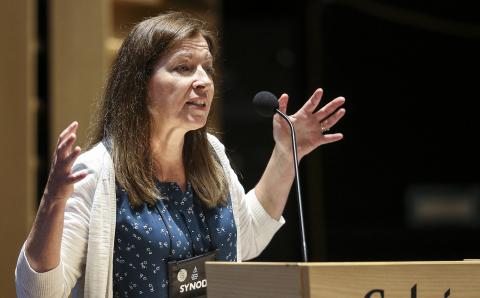When he was 13, Ernie Benally almost died. No one, not even the nurses, expected him to live. A rattlesnake bite was almost always fatal.
Traditional Navajos once had strong feelings about rattlesnakes, even worshiping them after a fashion, even though (and maybe because) they so deeply feared rattlesnake bites. Folk wisdom claimed that once the venom entered the bloodstream, the victim was forever poisoned.
In his own life story, My Walk of Faith, Ernie Benally says he had, from the time of the snakebite, a kind of reticence about him. He was shy—shyer, in fact, than his bashful father had been—in part because friends and acquaintances, even family, were hesitant to get near him. The kid held venom in his veins.
Just a few years later, in 1956, Ernie Benally was a rarity on the Dordt College campus: a full-blooded Navajo in a world of fair-haired Dutch-American students—and Calvinists at that.
After Ernie proved his abilities at the school in Rehoboth, N.M., the principal recommended he consider this new college a world away in a place called Iowa. So Ernie bought a ticket and got on a Greyhound. He’d been to Phoenix, where he’d graduated from the Phoenix Indian School, so Sioux Center was not his first experience off the reservation. But a quick trip through Ernie’s childhood illustrates just how much of a foreigner this Native American must have been in Sioux County, Iowa, in 1956.
Ernest Benally was born at home in 1935, in a hogan via traditional Navajo ways, his mother kneeling on a sheep pelt, holding to a sash belt hung from a sturdy log in the ceiling, his father behind her for support, while Grandpa chanted ceremonial songs. His mother always thanked him, he says, for coming quickly. Ernie was one of his mother’s seven children, the oldest boy. Navajo tradition not only allowed for bigamy, but even expected it when special family situations arose. So his father took a second wife and had six children with her.
The family sat on the floor when they ate meals in that one-room hogan. Even though neither parent had attended school, Ernie’s father respected those friends of his who had, those who held down respectable jobs. For that reason, his father would often tout the importance of getting an education.
Traditional Navajo medicine men were plentiful in his family, and their presence prompted Ernie to evaluate his childhood as being very religious—so religious, in fact, that his mother, who noted the strength of her son’s prayers and his love of singing, told him, “Maybe you should consider becoming a medicine man too.”
When he was 10 years old, Ernie Benally was enrolled at the Crownpoint government boarding school, where he first heard the gospel. Time each week was set aside for “religious instruction,” often led by a missionary who would tell Bible stories Ernie learned quickly to love.
Much of the Christian Reformed Church’s early mission efforts in the region were centered on this kind of religious instruction—an hour or so in which Christian people, many of them missionaries, could talk to boarding school kids about the Christian faith. It was government-approved and government-supported religious instruction.
That startling mix of church and state, unheard of and even illegal today, paid significant dividends. Ernie wasn’t the only boy or girl to come to know something of the gospel by way of religious instruction at the government boarding school.
But while it might seem that a government-sponsored religious program would be a wonderful blessing for spreading the gospel—and it was thought so at the time—religious instruction as just another feature of life in a government boarding school had the deleterious effect of making Christianity appear to be just another part of the cultural heft Native American people had to carry because of the colonizing power of white people. All too often Christianity became simply “the white man’s religion.”
In his life story, Ernie says he didn’t become a Christian at Crownpoint, even though the quality of those richly detailed stories was enticing (imagine not having TV or internet and hearing the story of the cross and the open grave for the very first time!).
One can, of course, enjoy the drama of a whole range of Bible stories and miss or not understand the nature of redemption. In his memoir, Ernie explains what happened to him and why the Christian faith was “challenging, in a way even fearful”:
Accepting and being led to accept the Christian way was fearful, because the missionaries didn’t tell me exactly what to believe in so much as they just told me the stories. In fact, to tell someone he is a sinner and must believe in Jesus Christ because he died for your sins is too much to grasp, especially when there is no such concept in your own religion.
Still, Ernie loved those great tales from Scripture. When he talked about those stories at home, however, he angered his father, who told him he hadn’t sent him to school to become a Christian. “You have your own religion,” he told his son.
But Ernie was determined to go his own way. When a number of people he trusted told him they believed he was being called by God to pursue more education—education that would lead someday to the ministry—that direction seemed to open for him. Their prompting and his own resolve put him on a bus toward a little junior college (enrollment 70) amid massive corn fields, a place that would very soon be given the name Dordt College (now University).
There is no record of how his fellow commuting students evaluated their food in 1956. The fare was as different as the different homes where they boarded. “My experience at Dordt was very positive,” Ernie says in his memoir. “I started out with a couple of immigrant roommates from Friesland,” which turned out okay, he says, “but the food was terrible.” It’s not surprising that a kid from the rez might find the food tasteless, but, even worse, he couldn’t help feeling the helpings he was getting were skimpy.
That the fare was bad explains what happened next to a man as much a stranger in a strange land as anyone coming through Ellis Island. One Sunday, when Ernie attended First CRC in Orange City, he was blessed by way of a dinner invite to the home of another student, Harold Bruxvoort. Even without fry bread the meat-and-potatoes of a hearty Sunday dinner at the Bruxvoorts’ came as welcome relief.
Mom Bruxvoort wasted no time when she heard Ernie’s evaluation of what he’d been fed. “Why don’t you just move in with us?” she said. He thought it would be a good idea. He could ride back and forth to Sioux Center with Harold.
So that’s what happened: a Bruxvoort blessing, even though Mom Bruxvoort never learned how to make fry bread. No matter—pot roast will do, Emie might have said. The truth? Ernest Benally put on 20 pounds during the two years he spent at Dordt College.
In May of 1958, Ernie graduated from Dordt, a junior college, with an associate of arts degree, having taken the pre-seminary track of Greek, Latin, and Dutch. No Navajo.
He went on to study at Reformed Bible College (now Kuyper College) and Calvin College (now University) in Grand Rapids, Mich., eventually completed a master’s in social work at the University of Utah, and went back home to the reservation to serve as the director of social work for Indian Health Service, working all around the reservation—at Winslow, Dulcie, Fort Defiance, and elsewhere.
One professional life later, he became ministry director of Classis Red Mesa for Christian Reformed Home Missions. Throughout his life, Ernest Benally’s service to and with the church was not without trials, at least some of which arose from the racism a Native man could experience in an overwhelmingly Euro-American church. In his first job as a mission translator, Ernie says, it was hard for him not to feel the kind of institutional racism that showed itself in distrust and discrimination. His life experience is a textbook of the perils that can undercut Indigenous ministry. In later years, via his own persistence, he served for many years as a lay leader for Classis Red Mesa, the largely Native American churches in the region.
Ernest Benally married Martha Jean Begay in Gallup, N.M., on Jan. 3, 1960. To that blessed union three girls—Deborah, Diane, and Tina—and one boy, David, were born. Years passed. Physical problems came along sometimes and made things difficult; emotional darkness swept in and out occasionally, as it has and does to many of us.
Soon after Ernie transitioned from his social work position to a new position with CRC Home Missions (now Resonate Global Mission), his beloved wife Martha developed pancreatic cancer and died just three months later.
His position as regional director of Home Missions brought him into contact with other professionals working around the reservation, including a schoolteacher named Ruth Brink Heil, whose grandfather, the Rev. L.P. Brink, had been a much-beloved pioneer missionary who created a written language out of the difficult Navajo tongue because he felt strongly that effective missionary work could not be done without knowing the language. After Martha’s death, Ruth became the second love of Ernie’s life. They married in August of 1997. Ernest Benally was 62 years old.
When the two of them required additional care, they moved their household to Michigan to be closer to Ruth’s daughter Susan and her husband.
A few years earlier, when Ernie and Ruth were in Michigan visiting family, Ernie looked up the telephone number of his old friend, Harold Bruxvoort, who’d spent most of his life teaching at Reformed Bible College. “I was so surprised to hear from him,” Harold says. Harold called three other old friends from way back in those early years at Dordt, and five of them, he says, had a wonderful visit.
Then, in May of 2021, Ernie called Harold again to tell him that he and Ruth were now living close, right there in Hudsonville. He called to say hello and to give Harold his address—and oh, by the way, Ernie and Ruth were looking for a Michigan church home. Harold, in a pattern begun 65 years before, invited them to his church—and they came. Soon Harold stopped over for coffee.
Ernie, sadly, was dying. He was 86 years old, and, as Ruth tells it, his body simply shut down in a way that soon made hospice care inevitable.
And now for sure this story of young men from such different worlds becomes everyone’s story. In Ernie’s case, the end of life was in sight. Hard of hearing for years already, his deafness kept conversations to a minimum. But even in silence, fellowship between old friends blossomed once more.
On three Sunday mornings, Harold Bruxvoort told Ruth that if she’d rather not miss church, he would be glad to come over and sit with his old college friend, who by that time was doing a lot of sleeping. Ruth smiled thankfully and took Harold up on the offer.
So for three Sunday mornings as the end drew closer, the two of them sat together, often in silence but together, two long lifetimes of service and worship between them, two Christian souls edging slowly toward what both believed was and will be, in one mysterious moment, both an end and a beginning. Together they marveled at the mysterious ways of the good God they had worshiped for so very long. They couldn’t help but agree, Harold says, “that God is faithful.”
Ernest Benally died Dec. 5, 2021, in hospice care.
Soli Deo gloria.
Editor’s Note: This article originally was published in The Voice of Dordt University.
James C. Schaap has contributed often to denominational publications, from occasional stories to a CRC history. After 37 years at Dordt University, he retired from teaching a decade ago and continues to work at writing. He and his wife are members of Covenant CRC in Sioux Center, Iowa.
About the Author
James C. Schaap is a writer who lives in Sioux Center, Iowa.








